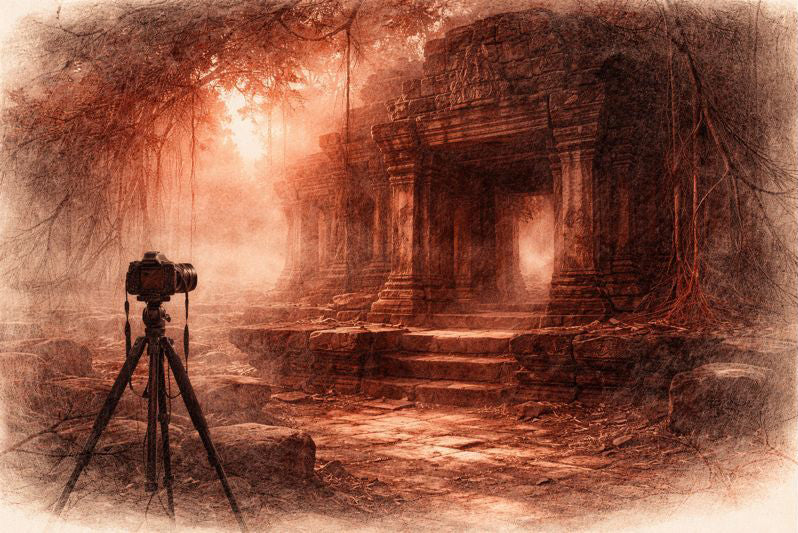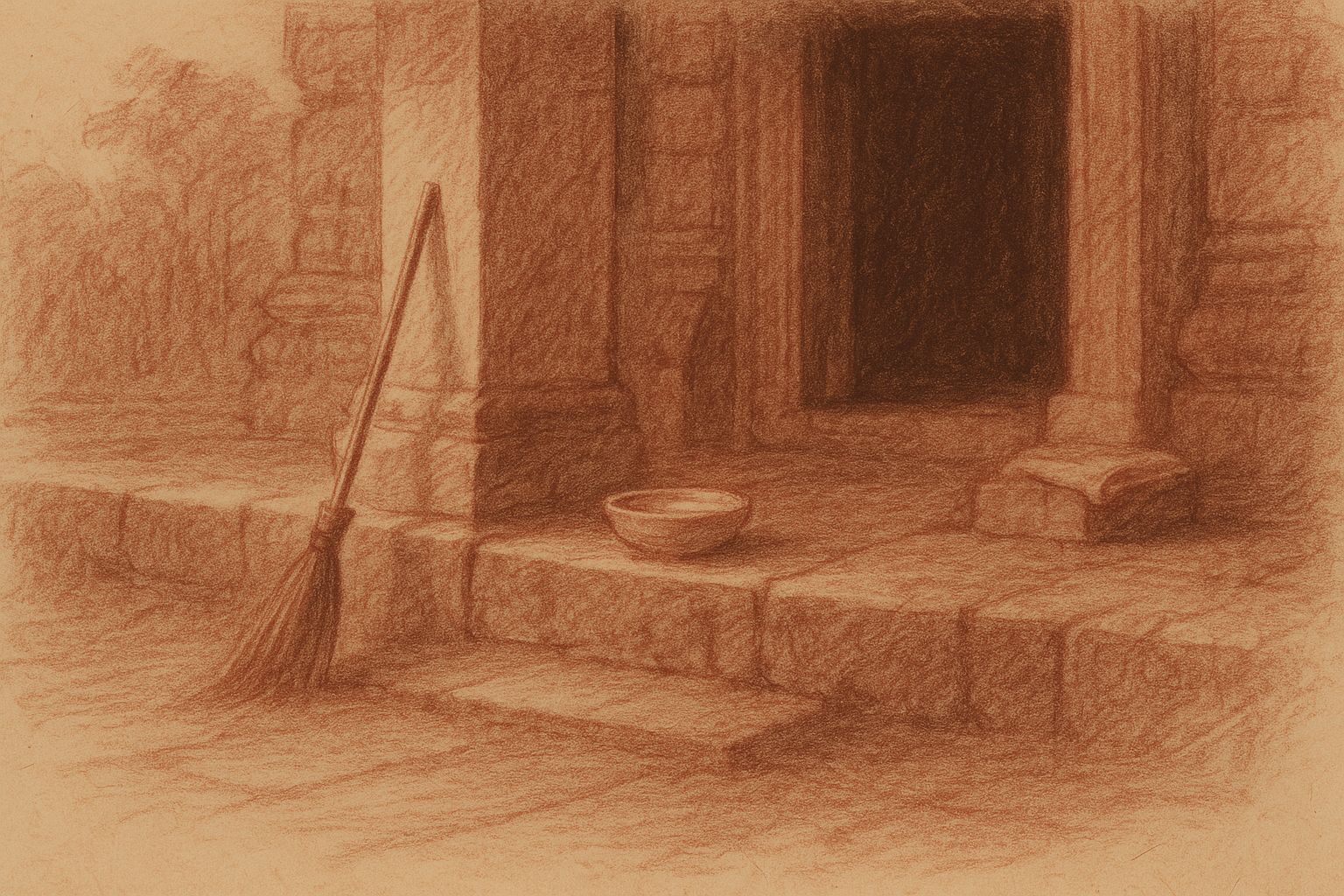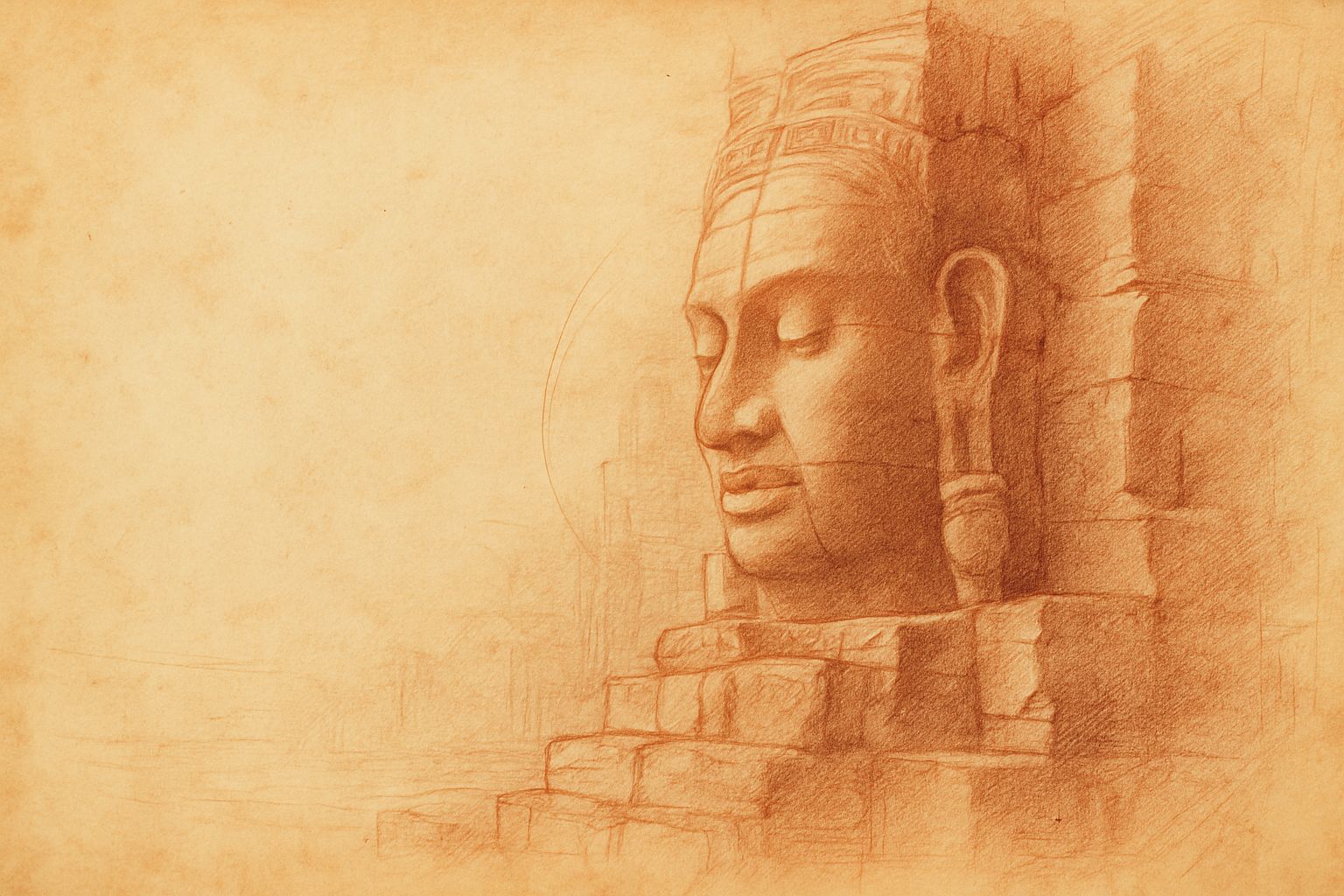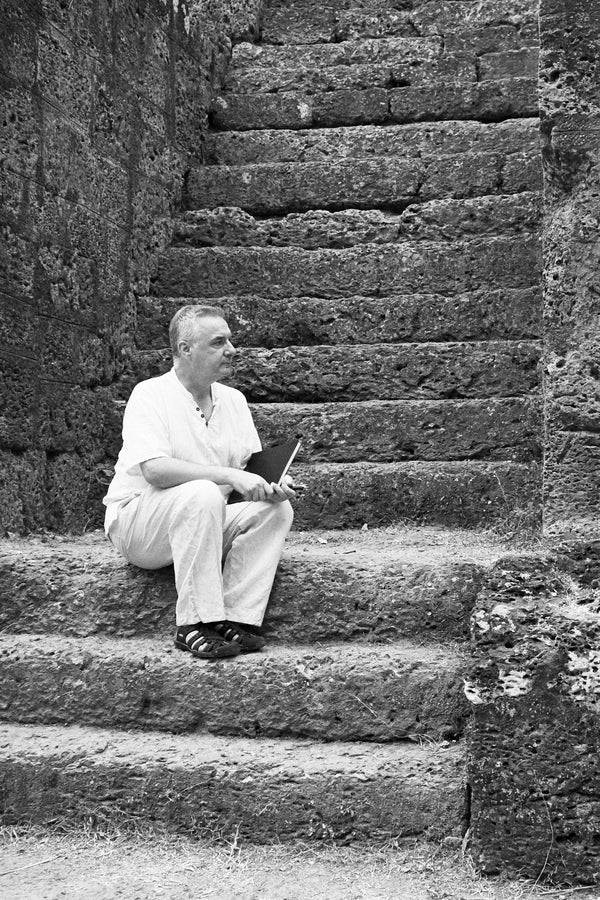Complimentary worldwide shipping on orders over $400 · No import tariffs for most countries
Complimentary worldwide shipping on orders over $400 · No import tariffs for most countries

The Vanishing Buddha: A Silence Carved in Stone
4 min read
Sanctuary of Meaning · Artist’s Journal
Lucas Varro
Where the image fades,
memory bends like old stone—
what remains is light.
—
There is a kind of sorrow I have come to know well in the temples of Jayavarman VII—a sorrow not born of time’s slow wearing, but of deliberate erasure. I felt it again today as I moved quietly through Banteay Kdei, Preah Khan, and the rain-darkened sanctuary of Krol Ko. I had come to sketch, but instead found myself kneeling in silence before mutilated stone.
Eyes once shaped in compassion—gouged away.
Lips that once held the still smile of Enlightenment—defaced.
Buddha after Buddha, seated in repose, now marred by haste and zeal.
It is not the weathering of centuries that wounds here,
but a violence of belief.
A coldness.
An absence carved by human hands.
These images—once countless—adorned pediments, lintels, gallery walls. They were placed with reverence under the reign of Jayavarman VII (1181–1220 CE), a king who filled the Khmer empire with symbols of mercy, healing, and the bodhisattva vow. Under his vision, temples became sanctuaries of spirit rather than triumphs of state. The Buddha sat not only on lotus thrones, but at the very axis of the cosmos.
And yet, scarcely a generation later, his likeness was hunted.
One cannot help but ask: Why?
History, here, offers only fragments.
Sometime in the 13th century, during or after the reign of Jayavarman VIII—a ruler devoted to Shiva—the work of erasure began. The inscriptions, once luminous beneath Jayavarman VII, fall strangely silent. What survives is the stone: gouged, scraped, altered with crude violence to obliterate the seated Buddha’s features. In some places, the entire body was excised. In others, only the face—
as though to unmake presence itself.
It is heartbreaking. And it is puzzling.
For centuries, there had been a delicate reverence between the great Indic faiths. Hindu and Buddhist sanctuaries stood beside one another. Patrons crossed traditions. Kings offered to Vishnu, Shiva, and the Buddha alike. Even Jayavarman VII, for all his devotion to Mahāyāna Buddhism, permitted shrines to Shaivite and Vaishnavite deities within his own temple compounds.
So what broke the balance?
Some believe it was his reordering of the sacred hierarchy. In temple after temple, he sculpted a kind of Khmer Trimurti—placing the Buddha in the centre, flanked by Brahma and Vishnu. Shiva, the Lord of Ascetics, was absent. To some Shaivite eyes, this may have seemed not syncretism but sacrilege. A denial. And in sacred orders, denial is rarely quiet.
Still, the destruction was neither total nor consistent.
In some sanctuaries, nearly every Buddha was effaced.
In others, like Banteay Chhmar, they were left untouched.
Even within a single temple—Preah Khan, for instance—one finds mutilated Buddhas beside those still whole. It is as though the hand of iconoclasm faltered, or was never fully sure of its own command.
At Krol Ko, a Buddha in full relief still sits calmly upon an outer wall, untouched—while nearby figures have been chiselled into soft, spectral hollows. At Banteay Kdei, some Buddhas endured perhaps only because later galleries, built in another phase, concealed them from view. Elsewhere, low relief and shadow became accidental protectors.
The pattern feels rushed. Incomplete. Uncertain.
Rather than a state decree, one senses a fever—localized, impassioned, carried out by hands that may have understood only fragments of what they were told to destroy. The focus was curiously narrow: the meditating, seated Buddha was targeted almost exclusively. Scenes of Siddhartha’s youth, or depictions of the future Buddha walking among mortals, were often spared.
It is as if the stone itself held more memory than the iconoclasts.
And so we live now with the silence that remains.
A hollow where presence once dwelled.
A scar where serenity once breathed.
I do not often photograph the defaced Buddhas. There is something sacred in their suffering, and something sacred too in leaving it unspoken. But I visit them. I sit with them. I sketch, sometimes—not to reconstruct what was lost, but to remember it. To bear witness. The very incompleteness has become part of Angkor’s sacred texture. A broken face beside an intact one is not simply visual dissonance—it is testimony. A revelation. That even the divine is not immune to impermanence.
And yet...
Buddhist monks returned to Angkor soon after Jayavarman VIII’s abdication. Zhou Daguan, the Chinese envoy who arrived in 1296, found them still walking in saffron robes. The dharma had not been extinguished. Theravāda Buddhism, quieter than its royal predecessor, settled gently into place—no longer carved into every wall, but carried in the breath of barefoot pilgrims and the hush of inner vows.
The temples bear their scars. But the spirit remains.
The destruction did not erase what was holy.
It only reminded us how easily even the sacred can be forgotten—
and how powerful it is to remember.
The gods may fade from stone,
but not from wind, nor from flame—
nor from hearts that bow.
—
What the eye no longer sees, the soul still kneels before.
Also in Library

Before the Shutter Falls
3 min read
Before the shutter falls, fear sharpens and doubt measures the cost of waiting. In the quiet hours before dawn, the act of not-yet-beginning becomes a discipline of attention. This essay reflects on patience, restraint, and the quiet mercy that arrives when outcome loosens its hold.

Those Who Keep the Way Open — On the Quiet Guardians of Angkor’s Thresholds
3 min read
Quiet gestures shape the way into Angkor — a swept stone, a refilled bowl, a hand steadying a guardian lion. This essay reflects on the unseen custodians whose daily care keeps the thresholds open, revealing how sacredness endures not through stone alone, but through those who tend its meaning.

Multiplicity and Mercy — The Face Towers of Jayavarman VII
5 min read
A new vision of kingship rises at the Bayon: serene faces turned to every horizon, shaping a world where authority is expressed as care. Moving through the terraces, one enters a field of steady, compassionate presence — a landscape where stone, light, and time teach through quiet attention.
Join My Studio Journal
Receive occasional letters from my studio in Siem Reap—offering a glimpse into my creative process, early access to new fine art prints, field notes from the temples of Angkor, exhibition announcements, and reflections on beauty, impermanence, and the spirit of place.
No noise. No clutter. Just quiet inspiration, delivered gently.
Subscribe and stay connected to the unfolding story.

Join My Studio Journal
Receive occasional letters from my studio in Siem Reap—offering a glimpse into my creative process, early access to new fine art prints, field notes from the temples of Angkor, exhibition announcements, and reflections on beauty, impermanence, and the spirit of place.
No noise. No clutter. Just quiet inspiration, delivered gently.
Subscribe and stay connected to the unfolding story.
